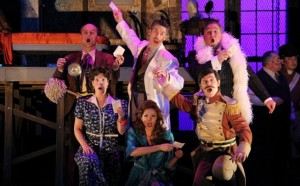The Barber of Seville: Modern take on the classic opera loses on atmosphere
The Barber of Seville by Gioachino Rossini, long proclaimed to be the opera buffa of all “opere buffe,” is one of the, if not the greatest masterpieces in its genre. It has been an audience favourite for almost 200 years (it was first premiered on February 20, 1816 in Rome) for a reason. Six years after its debut (in 1822), Ludwig van Beethoven said to Rossini (they were communicating in writing): “Ah, Rossini. So you’re the composer of The Barber of Seville. I congratulate you. It will be played as long as Italian opera exists. Never try to write anything else but opera buffa; any other style would do violence to your nature.”
So, what is so great about this opera? Of course, it is the music (in operatic art it always comes first). Rossini gives the opera his own signature with his bubbling, melodic style, very often compared to champagne. The expression “Rossini crescendo” is coined after his famous musical crescendo, which culminates in a solo vocal cadenza.
Rossini marries his intoxicating musical style with a simple libretto to create the perfect, comedic atmosphere. The Barber of Seville is a typical comedia dell’arte. The young and attractive Count Almaviva, disguised as a poor student, Lindoro, is in love with Rosina. He wants her to love him for himself and plans to marry her. The obstacle in his way is Rosina’s guardian, the aged doctor Bartolo, who wants her for himself. Here, the popular barer, Figaro, comes into play. He devises a scheme to help the young lovers, for a promised reward.
Opera Lyra’s production of this all-time favourite opera brings a change of atmosphere. There is a clear attempt to modernize it, probably in order to make it more appealing to a larger audience. It is the same opera that we have known for so long, but the setting and time is different. Here, Rosina is a movie star controlled by her impresario Bartolo and his gangsters. Figaro is a famous stylist, but count Almaviva is still a count. The plot is set in a film studio in the 1940s, which makes the story line of control, forced marriage and secret courting a bit unlikely, if not even out of period. Although the set is attractive, it doesn’t add anything to the performance. The only segment that resembles the 20th century is the costumes, beautifully designed by Parvin Mirhardy. Nothing else belongs in that century. And it would not, not with opera. Changing just the set and costume is not enough to change the period. There are mannerisms and psychology to take into account, which is impossible to change without changing scenes and even language (which would be an adaptation, of course).
With this attempt to “modernize” the opera (or to change it into a musical?), the essential segments get lost. The quality of the singing is often sacrificed in the name of entertainment, and characters in the name of comic physicality. While Peter McGillivray is Bartolo and Joshua Hopkins as Figaro manage to build comic and convincing personalities, the passion of young love between Rosina and Lindoro and the chemistry between the two is lacking.
Opera Lyra’s production of “Barber of Seville” is colourful and filled with humour and fun. From an artistic point of view, it still needs some work. A fresh and modern approach to classic art is welcome, but not at any cost. It can be done successfully only with a subtlety and if all components (including the period, story and character traits) make a natural fit. Sometimes, that is not that simple, especially with opera.
The Barber of Seville by Gioachino Rossini continues until October 3 at Southam Hall at the N.A.C.
The Barber of Seville
Gioachino Rossini
Libretto (based on Pierre Beaumarchais’s French comedy Le Barbier de Séville) by: Cesare Sterbini
Opera Lyra Production
Cast
Count Almaviva – Isaiah Bell
Rosina – Marion Newman
Figaro – Joshua Hopkins
Basilio – Giles Tomkins
Bartolo – Peter McGillivray
Fiorello – Benjamin Covey
Berta – Maghan McPhee
With the National Arts Centre Orchestra
Production Crew
Artistic Director – Timothy Vernon
Conductor – Giuseppe Pietraroia
Stage Director – Dennis Garnhum
Chorus Master – Laurence Ewashko
Principal Repetiteur – Judith Ginsburg
Stage Manager – Kelly Luft
Director of Production – Jason Dubois
Lighting Designer – Kevin Lamotte
